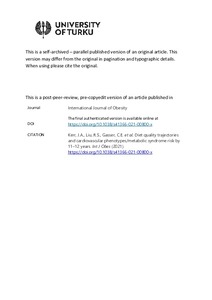Diet quality trajectories and cardiovascular phenotypes/metabolic syndrome risk by 11-12 years
Kerr Jessica A; Liu Richard S; Gasser Constantine E; Mensah Fiona K; Burgner David; Lycett Kate; Gillespie Alanna N; Juonala Markus; Clifford Susan A; Olds Tim; Saffery Richard; Gold Lisa; Liu Mengjiao; Azzopardi Peter; Edwards Ben; Dwyer Terence; Wake Melissa
https://urn.fi/URN:NBN:fi-fe2021093048814
Tiivistelmä
Objective
To investigate associations between early-life diet trajectories and preclinical cardiovascular phenotypes and metabolic risk by age 12 years.
Methods
Participants were 1861 children (51% male) from the Longitudinal Study of Australian Children. At five biennial waves from 2-3 to 10-11 years: Every 2 years from 2006 to 2014, diet quality scores were collected from brief 24-h parent/self-reported dietary recalls and then classified using group-based trajectory modeling as 'never healthy' (7%), 'becoming less healthy' (17%), 'moderately healthy' (21%), and 'always healthy' (56%). At 11-12 years: During children's physical health Child Health CheckPoint (2015-2016), we measured cardiovascular functional (resting heart rate, blood pressure, pulse wave velocity, carotid elasticity/distensibility) and structural (carotid intima-media thickness, retinal microvasculature) phenotypes, and metabolic risk score (composite of body mass index z-score, systolic blood pressure, high-density lipoproteins cholesterol, triglycerides, and glucose). Associations were estimated using linear regression models (n = 1100-1800) adjusted for age, sex, and socioeconomic position.
Results
Compared to 'always healthy', the 'never healthy' trajectory had higher resting heart rate (2.6 bpm, 95% CI 0.4, 4.7) and metabolic risk score (0.23, 95% CI 0.01, 0.45), and lower arterial elasticity (-0.3% per 10 mmHg, 95% CI -0.6, -0.1) and distensibility (-1.2%, 95% CI -1.9, -0.5) (all effect sizes 0.3-0.4). Heart rate, distensibility, and diastolic blood pressure were progressively poorer for less healthy diet trajectories (linear trends p <= 0.02). Effects for systolic blood pressure, pulse wave velocity, and structural phenotypes were less evident.
Conclusions
Children following the least healthy diet trajectory had poorer functional cardiovascular phenotypes and metabolic syndrome risk, including higher resting heart rate, one of the strongest precursors of all-cause mortality. Structural phenotypes were not associated with diet trajectories, suggesting the window to prevent permanent changes remains open to at least late childhood.
Kokoelmat
- Rinnakkaistallenteet [27094]
